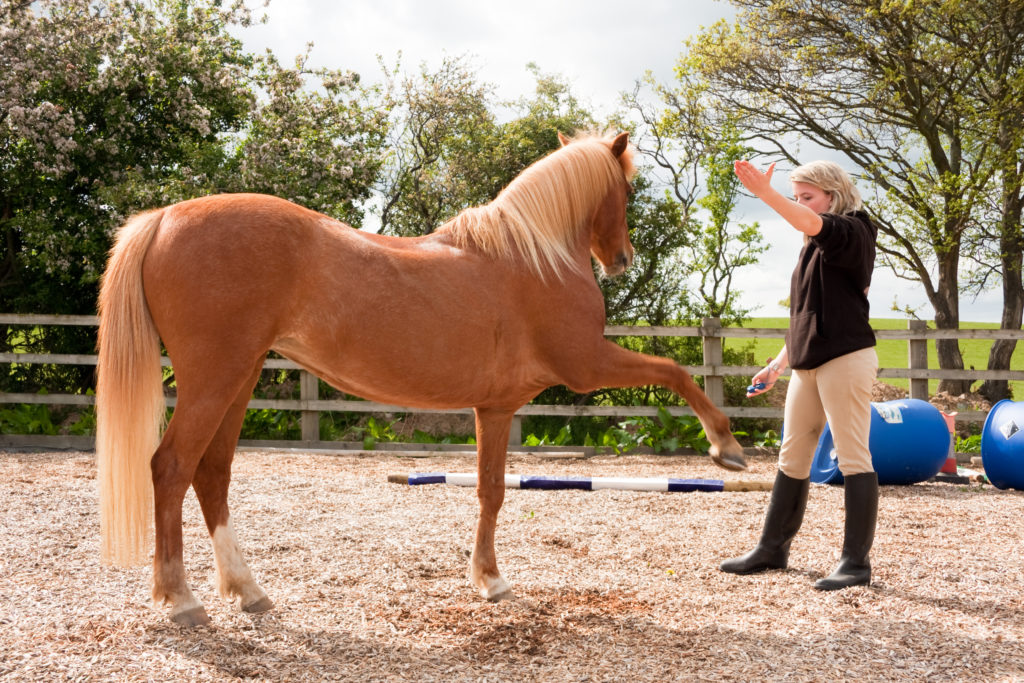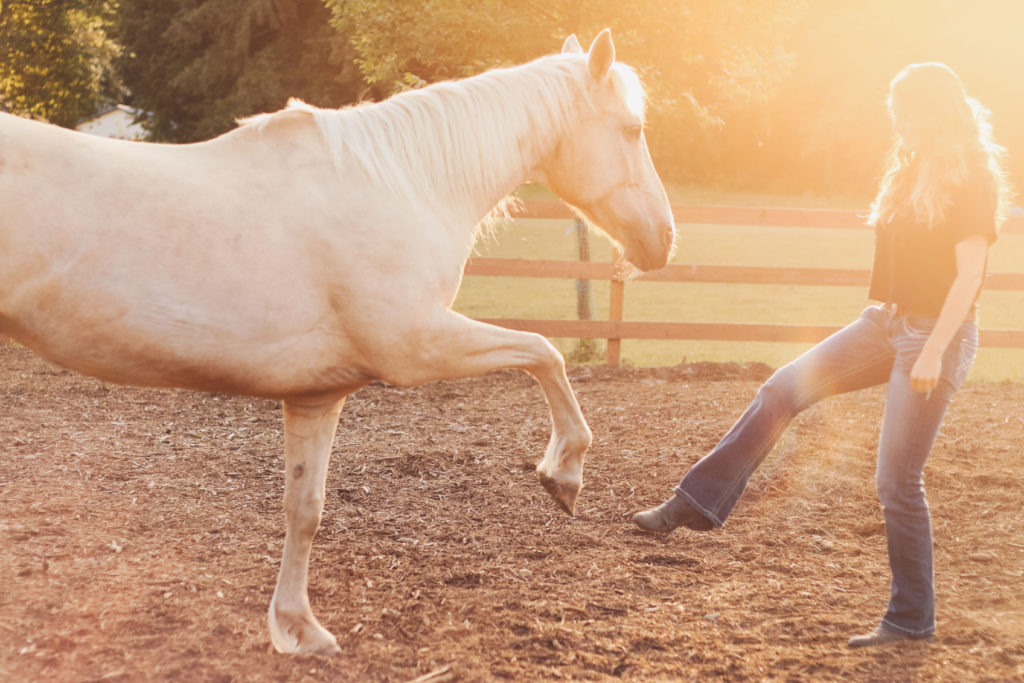
New Year, New Training Ideas
by Lisa Kiley – Published in The Horsemen’s Corral January, 2022. Photo Credit: Brittany McDonnell with Whisper, a BLM Mustang from Shawave Mountains Nevada HMA
As the New Year approaches and we are settled into the colder and snowy months, you may be looking for something fun to do with your horse that doesn’t require saddling up. Maybe you don’t have an indoor to work in, or you prefer to stay bundled up, but still want to feel like you are accomplishing something with your equine partner.
While the idea of clicker training for horses isn’t exactly new, the idea of using this positive reinforcement (+R) technique is something that is starting to gain ground in different facets of the horse world. Could this be the year that you decide to give it a try with your horse?
I had the chance to talk with Brittany McDonnell of The Equine Haven LLC in Ostrander, OH about how she has incorporated clicker training into her work with horses and humans.

McDonnell is a Licensed Social Worker who is also a lifetime horse person, and in addition to working with humans, she also runs a Non-Profit Horse Rescue where she utilizes positive reinforcement through clicker training. Her clients are also able to work with the horses within this therapeutic setting.
While employing the benefits of +R/clicker training now, McDonnell grew up as most of us do, using conventional training techniques and admitted that she wasn’t so sure about the concept at first. However, when she started working with wild Mustangs, it became very clear that many of the traditional methods she had been taught just weren’t going to work to gentle these feral horses.
Upon further investigation, the idea that she could teach a horse without punishment and/or negative reinforcement felt more aligned with the relationship she wanted with her horses.

What exactly is +R/clicker training? It’s a training method that is commonly with for dogs, but it is also used to teach all sorts of animals including elephants and dolphins and can be applied with horses as well.
As McDonnell described, you mark the correct behavior the animal exhibits by using the click and then reward following the click with a treat. As the horse begins to associate the behavior with the click and reward, they will start to seek to do the behaviors that are rewarded.
This means that as you are working with your horse, timing of the click and reward is important, so they can correlate what they are being rewarded for. In the beginning, the rewards should be frequent and high value. As the horse gets good at something, you can build duration between their action and the reward. Eventually the rewards will become increasingly intermittent but are never completely removed. The possibility of reward will keep them engaged and motivated.

While gaining in popularity, training horses with treats is out of the wheelhouse for many of us who have grown up with traditional horse training methods. Often, horse owners are admonished for giving treats at all, fearing it would lead to pushy, aggressive horses that learn to bite.
McDonnell was very clear that when properly trained, +R/clicker training using food rewards is not going to create a ‘treat monster’. She advises that one of the first things that should be taught is the ‘Calm Default’ – which she learned from Madison Shambaugh aka “Mustang Maddy” – this is when the horse learns to stand calmly with a lowered head.

The biggest key is that when training with food reward, the horse never be allowed to come to you for the treat. The reward must be given to the horse when the horse is standing calmly and staying out of your space. They will quickly learn they do not get any rewards for getting in your bubble.
She also advises that when you start using food rewards in training, you stop giving your horse random treats – this will help eliminate confusion and they will start to understand rewards come with correct actions.
McDonnell shared that one of the exciting things about clicker training is that horses pick up on it quite quickly and they start wanting to engage and work with you. She expressed that by creating positive associations with the horse, they are more confident in knowing what the right response is. This prevents working through confusion and fear associated with other methods.
However, you don’t have to completely retrain or change your program for your horse to benefit from +R/clicker training. There are plenty of things that you can work on from quietly picking up their hooves for the farrier to stress free trailer loading. Introducing +R/Clicker training is just a better way to build a strong relationship with your horse and can have a positive impact on how you work together overall as a team.

McDonnell encourages everyone to do some research on the method, there are many good resources available to help with understanding how your horse learns and can give a better foundation when trying something new like this. A clicker (or just a click noise) and some treats are all you need to get started. Start slow and make sure that you are asking your horse to respect your boundaries by teaching a ‘Calm Default’ first.
McDonnell also suggested videoing yourself so you can see if you are rewarding at the correct time and enlisting the help of someone who is more familiar with these methods is always a great idea. Check out McDonnells Facebook page @The Equine Haven LLC to get more information on upcoming clinics and training sessions.
It’s time for new year’s resolutions as we head into 2023, maybe trying something new with your horse should be on the list this year.
Cashmans Helpful Resources
Recommended For You
-
-
Stable Ground Mud Solution
$17.50











